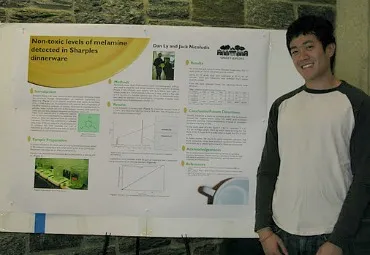Chemistry students prove Sharples dishware is perfectly safe, just not microwaveable.

Anyone who has fallen victim to the 6 o'clock lines and cold dinners at Sharples will recognize the warning posted on the microwave: "Please do not microwave the melamine dishware!" Many students find this caveat suspicious and can't help but wonder what noxious substances ultimately mix in with their ziti. But rest assured, Sharples diners, because Dan Ly '12 and Jack Nicoludis '12 have investigated the melamine dishware for Professor Alison Holliday's Chem 43 research project.
More specifically, Dan and Jack wanted to know what, exactly, the plastic dishes are made out of, as well as whether the breakdown components of the plastic (i.e., melamine) leak out at detectable or even toxic levels during microwaving.
Dan and Jack began by researching the methods that other scientists have used both to detect melamine and also to extract it from plastics. They decided on using a heated, dilute acetic acid solution (similar in composition to vinegar), especially since it mimics acidic foods and drinks like coffee. Approximately 250 mL of the acid would be left to sit in the dishware for an hour before boiling away all but about 2 mL of it. To separate and detect the melamine, they chose High Pressure Liquid Chromatography (HPLC), a technique which separates compounds based on how they interact with polar and non-polar molecules.
In the end, Dan and Jack found that all of the samples did in fact release melamine into the extraction solution, but at non-toxic levels. According to their data, it would take a great many bowls of microwaved soup for one to get melamine poisoning. They maintain that Sharples dinnerware is perfectly safe - just so long as one uses paper plates and bowls to microwave instead!
A PDF of Dan and Jack's research poster can be viewed here.
They both agree that this project was highly instructive, and in more ways than one. "The most interesting part of the project was that it was very applicable to our daily life at Sharples," Jack offered. "We use the plastic dinnerware every meal, and it made us stop and think, 'What are these plates made of? Are there any health risks from using them?' These are questions you forget about every day, but I think it is important to think about them from time to time. It keeps your life in perspective and makes you think about how your behaviors can affect your health and well-being."
Dan and Jack would like to give their sincerest thanks to Professor Alison Holliday and Caroline Burkhard for all of their help in the lab, as well as to the folks at Sharples for donating the dinnerware.



